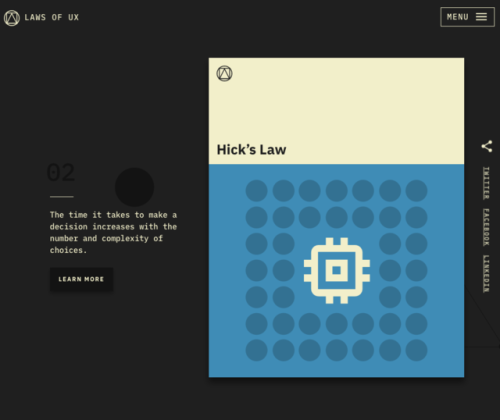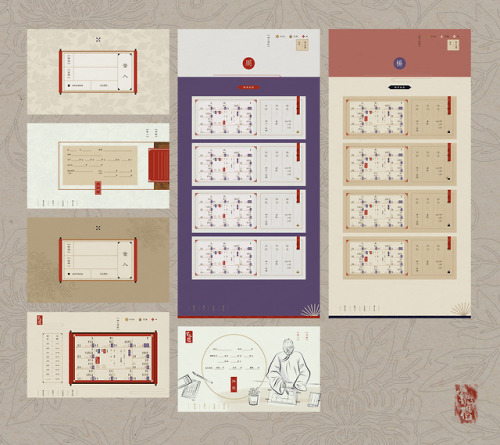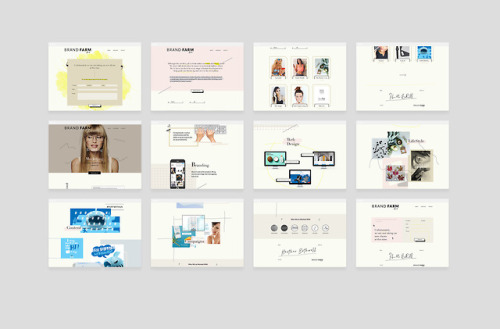#user experience

Traditionally I come from a country where coffee is a staple moment of everybody’s routine at home or outside. In Italy you start the day heating your moka and waiting for that unique sound ready to serve two small cups; if you’re on the go, your espresso and a Nutella croissant with the newspaper under your arm depict the average bar goer in the morning. Plenty of cafes placed here and there that offer this important drink at any time of the day.
In Italy there isn’t that status-quo of tallorgrande paper cups to carry around while going to work or while driving to get the kids from school. However, the market for coffee in North America is a well established business that in the last twenty years managed to go beyond the beans, entering a whole new dimension of corporate branding and personal status.

Today sporting a cup in your hands is not about taste anymore, but about who you are. That cup is a beacon sending a subtle message to others about your life style and preferences. Corporate identities acquired a more powerful aspect when designers begun working with the experience element to be used in the equation. Advertisers could only go so far in convincing people to buy this or that product, that’s why understanding the user was essential to the business.
Famous brands like StarbucksandTim Hortons are the two essential names in coffee consumption in Canada. The former constitute a different brand loyalty from customers than the latter which attracts a different crowd. Starbucksis not just coffee but a way of life. Those who hold that large white paper cup with the green logo on it are not just drinking their beverage, they are telling others around they belong to another plain of society, usually a middle class and above, and they enjoying being seen with something in their hands that is a totem of status-quo: I can afford an expensive coffee and I belong to a circle of people similar to mine (usually the white collars).
On the other hand the Canadian chain Tim Hortons is a business which belongs to a broader percentage of the population; it encompasses the average Jane and Joe which rise early in the morning to go to work, who hold a trade which involves labor and specific manual/technical skills; I’m thinking about your neighbor carpenter, your middle school teacher, the plumber who just repaired your sink, the road worker with the yellow vest. It’s essentially a blue collar coffee for it’s accessible price and quality.

Two distinct cups for two distinct brands. Starbucks focuses more on the logo to visually engage those around the cup in suggesting status; Tims sports a different interaction with the user to engage a larger crowd through cost and quality accessibility.
The behavior of these two brands is visible everyday at any moment, whether at the mall, outside offices, while doing groceries, at the bank. Those who spend twice as much for coffee at Starbucks want to be seen, and that’s why the cup is designed to stand out: white with the bright and visible logo that is unique and easy to identify. It never changes. Whereas Tim’s has its cups shifting throughout the year in style with different seasonal themes and prize winning months (Roll Up The Rim contest).
So, in this quick analysis of coffee, the choice of cups goes beyond the beans; it’s not just the quality but a way of expressing one’s personal status and kinship to a specific mindset or group of people. There are other brands that might have worked too making the comparison; however, in Canada this polarization of brand choice offers an outstanding window of user behavior just by looking at a cup of coffee.
During my research for the subject of suburban planning and its social isolation I stumble upon a wonderful specimen of poor urban design in the state of Missouri, where the nefarious housing pods hosting cul de sac and twirly roads is the realm for car culture.

The whole looks like any other American suburban community with the freeway skimming residential areas, the collector defining the neighbors, and then smaller roads extending everywhere until they meet all houses.

I wanted to plot an hypothetical visit of one neighbor to the other and this is the result. It’s a three miles trip by car that will take at least 9 minutes because there are no opening in the shape of a road or pedestrian path to connect the two points.

This is how it appears from top-down view with a series of semi-natural and artificial barriers that separates the cul de sac on the right with the curb on the right. Two worlds apart basically because of arcane and mysterious reasons that impelled urban designers to totally exclude any sort of travelling from one side of the neighbor to the other. Picture if the neighbor’s house is on fire and you want to help them escape death; you won’t probably because you either climb over the two fences and the trees, or you drive your car but that’ll take 9 minutes and who knows if people there are still alive by then.

Highlighted in red it’s the whole barrier of fence and trees that separate the neighbor in two distant sides, where socializing can be as difficult as Berlin in the 1950s between West and East.

To avoid your other neighbor doesn’t get the chance to invade you, the developers built an artificial canal (highlighted in blue) to furthermore make sure people don’t get together and come up with crazy ideas like socializing. In yellow the broken connection that might have been existed with a pedestrian path, but better not take any chance.

Here’s the site from another point of view and you can see how the whole portion doesn’t allow for people to walk or drive to the other side, splitting the pod into three areas.

I zoomed as much as I could and you can see it’s not just a road network issue anymore but a lack of safety feature that could help people stay away from danger. After all these are places where families with young kids live.
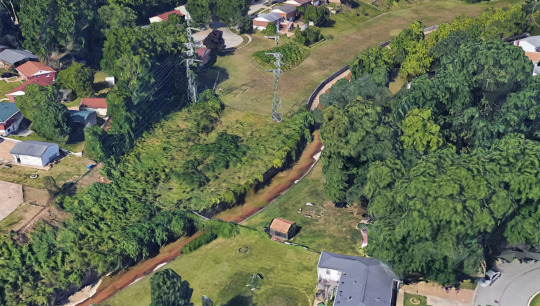

In yellow I highlighted the dangerous areas where the lack of fence around the power lines and the canal have allow for free access; anybody can go unrestricted near the pylons and the ditch. Unsupervised kids face the most peril especially when it’s right around their backyard. Coloured in magenta it’s what appears to be a narrow bridge but in fact is a floodgate connected by another fence to the little shack on the right.
Notice also the lack of sidewalks everywhere; this tells us a lot about the urban design of housing communities where the pedestrian was left out of the picture in the first place. People going for a walk have to be in the street increasing the risk of being struck by a vehicle, this shows us the very weak UX design home owners are affected, but also emergency vehicles who might get tangled driving streets which have been badly shaped.
What does this mean?- We live among cities that are the result of zoning laws which manufactured landscapes dictate by cars first and people second. In North America there’s nowhere a car couldn’t go from the driveway to the drive-through of your local burger joint; drive in movies for cars, parking lots eating away downtown portions of many cities, and many other issue which gets in the way of creating healthier places to live.
UX design is not only about websites and phone apps, it extend its dominion onto any other experience the user goes through that can be as simple as opening a pickle jar or driving to work. Both these elements engage people into specific and different behaviors which can result in the success of failure of products and services.

If you take a stroll between downtown restaurants, suburban strip-malls, food courts, you can clearly see the trend of the last decades of burgers, fries, chicken wings, beer. They are everywhere and have been everywhere between local menus and the frozen food section of our grocery store.
Now food franchises like Buffalo Wild Wings, TGI Fridays, Applebee’s, are reporting declines in sales and restaurants closures according to this Business Insiderarticle, where millennials are once again blamed for this food crisis and bad financial news.
Let’s take a step back and analyze the situation by identifying these restaurant names. For the past thirty plus years this kind of chain business, which spawned throughout North America, has been serving one type of menu: burgers, fries, chicken wings, beer. It has become a staple of limited food choices for this bracket of casual food joints.
Whether the burger is on a sesame bun or the wings are super hot it has made little difference and the fad of new opened places did not last long. People have become tired of the same rehashed plates, interior designs, atmospheres, menu offers, while at the same time price convenience has diminished along with food quality.
The sum of all these elements has generated the poor customer experience people have gone through in recent years. Internet has broaden up the food views of millions of people between US and Canada, and so the appetite to try new dishes. Also the recent rise in gourmet food sparked the interest of more genuine alternatives many are willing to pay more than the average combo meal at the same old joint.
Customers don’t want to give up burgers, fries, and wings yet; however, as of 2017 who isn’t selling these foods? From cheap and fast places like McDonald’sandBurger King, to more refined places like Five GuysandBurger Priest, and from Hooters to any sport bar out there that is serving wings and pints of beer at any given night of the week.
Trends do change and we are amidst many of them in terms of food and retail choices. Yes, millennials are part of the equation but it’s not only them who are responsible for this shift in the restaurant industry. Families are an essential part of this business too and started making more conscious eating choices, since prices aren’t that convenient anymore at these casual eateries, they decided to spend the same cash elsewhere.
Alternatives likeChipotleandPanera Bread have given better meal alternatives by bringing new flavors and healthier choices than regular frying pits. Now this has brought an interesting challenge to the restaurant industry by testing the status-quo of the fast-food standards due to this change in consumer behavior.
We also have to mention how the food service is affecting the landscape in terms of distribution.UberEats, Foodora, JustEat, have swarmed cities giving more alternatives to the usual delivery food at your door. Now you can order your favorite Indian or Afghani dish without having to take everybody to the restaurant, but comfortably sitting at home through the quick use of an app.
At this stage millennials are an influential portion of the revenues for the food business, in fact this young generation prefers to spend more for higher ingredient qualities of meals while enjoying better experiences.
Gourmet restaurants have given a serious shift in eating option by emphasizing better dish preparation and variation. Vegetarians, vegans, celiacs, do represent a large customer base that does not conform to the selection of drive-through or casual restaurants choices.
So, it’s correct to say that chain restaurants are loosing sales and shutting down not really because of millennials, but for their lack of diversification in menu options, food quality, repetitive flavors, high prices. Not only retail brand names have been affected in recent times, but now also famous name in the food business.
The second decade of 2000s has proven to be a hard challenge for many businesses including well-established names. Consumer behavior has shifted path from a mainstream choice to a more indie approach of eateries. Social platforms like TripAdvisor, Yelp, Facebook, Twitter, carry out the democratic voice of customers with their opinions and reviews of restaurants, but also helping carrying the message of less-known restaurant names towards fame.
Food trends have changed quite a bit in the last years where small independent eateries have brought up fresher and newer alternatives, competing versus established names. Also, new delivery methods have contributed to increase the range of service and approaching new customers.
If the restaurant chain business want to halt their sales slumps and location closure they ought to modernize now, they cannot wait entering 2020 without a solid plan for better food choice and eating experiences. This must happen by giving up old habits and reinventing their practices by catering towards different customers with brand new strategies.

Melbourne millionaire Tim Gurner went off to fame recently after stating on the TV program 60 Minutes, that millennials ought to save by skipping on their expensive avocado toasts in order to buy their dream home. Avocado toasts are now the new BigMac index on purchasing power.
Things change quite fast in the age of information where the economy doesn’t serve well as much as it did for millennials’ parent. Back then household expenses were limited to the analog world of mortgage payments, groceries, and transportation bills.
Today the door revolves the other way. The new generations have different goals that don’t reflect the Baby Boomers’ ambitions and we all should take notice about it. The Avocado Toast Index is becoming the new marker of the purchasing power for which this new generation of tech-citizens is being measured for.
Some may argue that: “When I was trying to buy my first home, I wasn’t buying smashed avocado for $19 and four coffees at $4 each,” isn’t the way to approach financial independence. However, we should argue over what brought spending that much on a veggie toast since it’s so popular.
Millennials are drifting away from repeating the financial patterns of their parents and getting into debts by mortgaging an over-inflated piece of property they can release in 20 to 40 years from now from their bank. Millennials tackled the new reality of economics by denying the old approach of becoming subjugated to indebtedness.
Those born between the 80s and the 90s are defying the status quo by following their own interests on housing rental and purchasing, away from any real estate expectation. Millennials prefer living downtown cities in order to experience the city lifestyle without the stress of the suburban commuting and social isolation.
Markets ought to observe this generation much closer without drawing cheap and antiquated marketing data conclusions. There’s a lot that needs to be analyzed and understood from the millennial user point of view which can bring favor to many companies that are willing to listen.
There’s so much we can learn from the Avocado Toast Index because it has now given us a way to understand the spending habits of a growing and intelligent community.

The presence of digital markets has changed the relationship between the user and companies; the engagement of behavior and values is today more sophisticated because of the introduction of variable in the UX. Too many companies still struggle understanding how to connect with their customers.
It’s important to makes sure companies understand their target audience quite well in order to assume the product/service meets the user expectation. Many startups fail in their early years because stakeholders do no focus on the user side. Creating a product comes with a complex structure of passages and too often companies loose sight of their target audience.
This happens when the business persists with conservative marketing strategies that belong to the analog era and don’t consent innovation to happen. Designers begun to break away from the traditional doctrine of the marketing department to seek new philosophies, simply because there’s much more than just using analytical data and projections to address the user’s identity.
The best vivid example of disrupting the traditional scheme of strategic thinking can be attributed when Apple introduced theiPhone. A company that had nothing to do with the telecom field managed to swipe clean a market, introducing something they never worked on before. Then we all know what happened to the conservative approach on UX design where the Blackberry almost disappeared from the market because the managing team couldn’t understand the new approach to touch screens.
This is what companies can learn from designers: move away from your comfort zone and embrace changes to stay competitive, even if crazy ideas are thrown on the table; they are worthy to be considered. Consumer behavior changes very fast through external factors that cannot be controlled by companies, so it’s essential stakeholders follow a progressive UX design that has the ability to truly connect with the user in order to cater to its needs. Without that companies are just building products and services just for themselves.
5 UI UX trends to follow for 2020
14 User Facts Every UX Designer Show Know!
Are you in the process of creating or redesigning your website? Want to better understand your website visitors to ensure your new site is a success?
Infographic:https://blog.red-website-design.co.uk/2018/07/26/web-design-facts-infographic/
Post link
[UI / UX] Summertime Hustles pt.3
https://www.behance.net/gallery/105522477/UI-UX-Summertime-Hustles
Post link
[UI / UX] Summertime Hustles pt.2
https://www.behance.net/gallery/105522477/UI-UX-Summertime-Hustles
Post link
[UI / UX] Summertime Hustles pt.1
https://www.behance.net/gallery/105522477/UI-UX-Summertime-Hustles
Post link
“紫薇命盘” website design.
-
Client: Tony Arms.
Date: 12.2016-1.2017
Art Direction : Jun-Yao Yu
Visual Design : Jun-Yao Yu
Illustration : Jun-Yao Yu
-
Twitter | Instagram | Facebook | Shop | Pinterest
Post link
elipsis App design.
-
Client: Yasmine .
Date: 7. 2017.
Art Direction : Jun-Yao Yu
Visual Design : Jun-Yao Yu
Illustration : Jun-Yao Yu
-
Twitter | Instagram | Facebook | Shop | Pinterest
Post link
Brand farm website design.
-
Client: Heather Bothwell.
Date: 4. 2017.
Art Direction : Jun-Yao Yu
Visual Design : Jun-Yao Yu
-
Twitter | Instagram | Facebook | Shop | Pinterest
Post link
Improve UX For A Better Business
Improve UX For A Better Business
How to improve the user experience? Here are some practical actions. When reading the pillars of user experiences, surely, some actions and strategies that allow promoting it come to mind. Precisely, here we will delve into those key practices that drive the User Experience and guarantee the achievement of great results. You should consider a usability testing framework.
Photo: Unsplash
1.…

A brief summary of how user engagement is tracked on Tumblr, for the newcomer:
- When you like or reblog a post, that counts as user engagement for the person you liked or reblogged from, and shows up in their notifications.
- If the person you liked or reblogged a post from wasn’t the original poster (i.e., you’re liking or reblogging a reblog), it also counts as user engagement for the original poster, and shows up in their notifications as well.
- This means that user engagement from your likes and reblogs can potential accrue to two different people, the original poster and the person you liked or reblogged from.
- Consequently, you cannot “steal” user engagement from someone by reblogging their post.
- This is one of the very few areas where Tumblr is actually functions more reasonably than other social media platforms.
- Note that this is only true if you use Tumblr’s built-in reblogging function. If you save someone else’s content to your local device and append it to a new post, you effectively become the original poster from that point on.
- This means that on Tumblr, “reblogging” and “reposting” are two different things; if you see someone complaining about “reposting”, this is not the same as reblogging.
- Commenting when reblogging does not affect any of this – unlike, say, Twitter, where quote-retweeting causes user engagement to accrue to the quote-retweet and not to the original tweet – and you can and should do so freely.
- However, every Tumblr user can see who exactly you reblogged a post from, which functions as a soft disincentive against making inane comments; if you make a dumb comment on a reblog, people who see your reblog may “back up” one step in the reblog chain to reblog a version of the post without your comment.
- Nobody understands tags, and there’s a fair amount of evidence that how tags work changes periodically and without warning.
- Tags are a divine mystery.
(For those going “how is this not obvious”, it’s about prior expectations, bro. On many major social media platforms, using the built-in sharing tools does divert user engagement from the original post. For example, as noted above, quote-retweeting on Twitter causes likes to accrue to the quote-retweet instead of the original tweet. This is because Twitter is hostile to human life.)
It’s really good for stuff like this to go around every once in a while! Strange as it may seem, people may in fact migrate here from Twitter or Instagram, where this stuff works differently and where there are different expectations of engagement.
DON’T FORGET - *most* Tumblr users DO NOT MIND if you engage with their OLD posts! (Apparently on Instagram they do? this baffles me.)
Many also don’t mind if you “spam” their notifications with a bunch of likes or reblogs in a row.
Tumblr has a rich culture of Very Old Posts continuing to make the reblog rounds, and people become fond of them.
Also, unlike Twitter, you can reblog the same post multiple times. Heck, you can reblog the same post every hour on the hour for days. (Please don’t.) But you do see a lot of “oh this came across my dash again, must reblog” with posts users are fond of. This is fine.
Tags ARE a divine mystery. People use the tags both for organization (inasmuch as this works, sometimes), and for added commentary. Commentary added to the tags will generally be seen by those who follow that person and see their reblog on their dash; but the OP and whoever they reblogged it from can also see the tags in the notifications.
So again – you can use the tags for commentary, and many people do. But people WILL see it. It just won’t “stick” with the post… necessarily. Tumblr also has a culture of people seeing some tags they think are relevant or clever, and reblogging a post with someone else’s tags included. So bear that in mind as well – something you put in the tags could get “pulled up” into a reblog chain by someone else, and this is generally seen as fine.
Just an amusing musing from someone whose done UX before… and why I don’t follow site protocols for my own mental health. Also, picture the caps as a version of a screaming baby with their icon as a mask over their face. Or is that how I imagine it?
TUMBLR
REBLOGGGG DAMN YOU REBLOG!
I reblog occasionally. I’m not focused on boosting followers by random reblogging. I’m focused on delivering best content. I did do reblogging a lot in the past on other accounts, but then the contents got messy and I rather reblog the things that are relevant to the focus of the blog. Also, I have a custom name for the website and it’s professional type website, so going into tumblr black holes isn’t for me. I rather escape velocity of internet black holes. The QAnon effect is real.
HAVE YOU SEEN…
Dun care.
Dear Tumblr,
I wish you had an auto save feature that saves to drafts… also, your platform seems to have trouble processing long posts. Javascript handling error, I suppose.
MYSPACE (lol I remember it)
Put up music, flashing gifs, list allll your profile info. Give us your personal contacts.
I’m HSP, though I didn’t know it at the time because the term wasn’t invented. And generally, sharing your personal contact info when your name (at the time) was rare, is a BAD idea. Stalkers with no protections is terrible. And I stopped using the website around the time they allowed animated gif wallpaper. !@#$ No. Also, automatically playing midis gave me a fright from my childhood PTSD and HSP-ness. I was also underage… sooo…. no.
Dear My Space,
You were a nightmare for HSPs and Autistic people. Also, it was hard to network on you. Also, you didn’t really protect minors that well.
POST A PICTURE OF YOUR FACE~~
No, you racist assholes. No.
True story, in a PRIVATE group, I posted my face and then Facebook bots came after me left and right. I deleted the single picture and Facebook stopped coming after me. We know you’re racist, you assholes. Why should I post a picture of my face when you’re going to try to chase me off the website.
JOIN MORE GROUPS
Too much work to keep up with them. Facebook isn’t my life. I rather have a handful I engage in rather than 1000 plus.
HAVE MORE FRIENDS 5,000!! 10,000!!!
You mean faceless strangers I don’t know to feel popular? Popularity isn’t my goal in life. I don’t need the internet to validate my existence.
Unfortunately the internet doesn’t often go towards my values of empathy, kindness, seeing people as human beings, and *friendly* debates. So accumulating people I don’t know who could attack me, no. I filter hard.
GIVE ME YOUR PERSONAL INFO
I’m no longer a minor, but stalkers exist and data mining on Facebook makes it easier to do things like, say Credit card fraud. So NO. Fuckers, no. Also, stop selling my info to scammers.
ARE YOU SURE YOU WANT TO UNFRIEND THIS PERSON?
yes.
ARE YOU REALLY SURE YOU WANT TO UNFRIEND THIS PERSON?
Yes. YEEESSSS.
Dear Facebook,
Good luck finding liberals who are blatantly racist transphobic and hate Republicans. That’s what your algorithm tells me. This is why you lost users after the announcement. But you don’t want to admit that you’re racist. Oh and I beat your racist algorithm. You really should remove the racism though you know about it and won’t do anything about it.
DO YOU KNOW YOU CAN FOLLOW MORE TOPICS?
Yes. Am I going to? No. Are you going to push them on me anyway because your bots come after my tweets? Yes. Do why are you asking me to follow topics?
YOU CAN FOLLOW FEEDS.
See previous. Also, QAnon effect often happens when one follows feeds and that gives me a headache.
FOLLOW THESE PEOPLE BACK
HSP, information overload. Honestly, I’d probably cut back on my feed. I can’t control the topics on my feed. I can’t control people replying to me but not intending to. Why do I want more of that in my life. It’s not real validation.
YOU KNOW YOU CAN MUTE PEOPLE YOU FOLLOW
Then what is the point in following them unless they give you a job offer and you just want to DM them?
RELOAD/CLICK ME SO YOU DON’T LOSE YOUR PLACE.
I know why they added this feature. Yes. But still feels like they want to suck your soul out from your foot and make sure you don’t have a life outside of twitter.
Dear Twitter,
I noticed that your social media platform has a bunch of users who seem to be hung up only on the platform and have no life outside of it. This is not healthy since too much social media leads to depression and bad behavior, and the QAnon effect. Also, it would be nice if there were not necessarily “Inspiration porn” but the occasional funny or amusing news in amongst the terrible.
General note: I tend to block or not connect my face to face friends and my family members just so they will ask: How have you been and try to actually contact me, rather than say nothing. This is a huge social media sin, apparently, but it saves my mental health quite a bit.
Conclusion
I use social media badly. I know UX, so there are two things I think UX on social media could fix: The QAnon effect–that is where you get into increasing weirder social media black holes. And the lack of user to user empathy causing social media burn out. If you want people to stay on the website, then fighting social media burnout should be a goal of social media websites. I have a few theories to get there, but UX is so focused on UX person to user, that it’ missing a large part of the User Experience: Interaction with other users. And User Experience can shape that.
Oh and FACEBOOK STOP BEING RACIST. That’s my UX hot tip for you. Make a big announcement about how you’ve changed the algorithm. Also, don’t allow foreign bots to do credit card fraud.
I believe the way forward for UX is to try to create empathy and common ground, but I get rich people, programmers’ egos (a joke programmers would get) and UX people these days are more focused on individualism, which BTW, goes against the social part of Social media. So the next level would actually be leaning into the community and social parts of social media by looking at social media as tiny governments and societies and then looking at ways to shape that community from the first to get there. But then you’d need social scientists of different types to get you there.




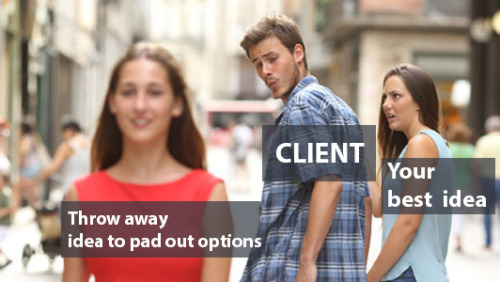
![[UI / UX] Summertime Hustles pt.3https://www.behance.net/gallery/105522477/UI-UX-Summertime-Hustles [UI / UX] Summertime Hustles pt.3https://www.behance.net/gallery/105522477/UI-UX-Summertime-Hustles](https://64.media.tumblr.com/8e4a44c94d07aafeea9de8fc5097e13f/9af92c6e07ceccc0-cc/s500x750/c1547f8794bba487fde7b041531e69e05a61cb27.jpg)
![[UI / UX] Summertime Hustles pt.3https://www.behance.net/gallery/105522477/UI-UX-Summertime-Hustles [UI / UX] Summertime Hustles pt.3https://www.behance.net/gallery/105522477/UI-UX-Summertime-Hustles](https://64.media.tumblr.com/be52ef42ed3a8947d4c7da571d8cab00/9af92c6e07ceccc0-6b/s500x750/bb8cda31de2c473fc02700cea76c35780592b7d5.jpg)
![[UI / UX] Summertime Hustles pt.3https://www.behance.net/gallery/105522477/UI-UX-Summertime-Hustles [UI / UX] Summertime Hustles pt.3https://www.behance.net/gallery/105522477/UI-UX-Summertime-Hustles](https://64.media.tumblr.com/af6d904f3463e6de698f68adc919afb1/9af92c6e07ceccc0-22/s500x750/16499f80130ee64d0078fb3c93512f428ecd3bbd.jpg)
![[UI / UX] Summertime Hustles pt.3https://www.behance.net/gallery/105522477/UI-UX-Summertime-Hustles [UI / UX] Summertime Hustles pt.3https://www.behance.net/gallery/105522477/UI-UX-Summertime-Hustles](https://64.media.tumblr.com/fcb81a345755217fbbd513dcd3884c35/9af92c6e07ceccc0-31/s500x750/b5fc5695d59079da53dddd4e7bcb68f345b1f6f2.jpg)
![[UI / UX] Summertime Hustles pt.3https://www.behance.net/gallery/105522477/UI-UX-Summertime-Hustles [UI / UX] Summertime Hustles pt.3https://www.behance.net/gallery/105522477/UI-UX-Summertime-Hustles](https://64.media.tumblr.com/d1f289e1284965bd9db1cf5c79c76737/9af92c6e07ceccc0-49/s500x750/f36380803220cc2f61523cc4dbaa6e74dafdcd97.jpg)
![[UI / UX] Summertime Hustles pt.2https://www.behance.net/gallery/105522477/UI-UX-Summertime-Hustles [UI / UX] Summertime Hustles pt.2https://www.behance.net/gallery/105522477/UI-UX-Summertime-Hustles](https://64.media.tumblr.com/f5495f4b2b8519b2aee901ce515db8d4/46eb729dbd816a52-f5/s500x750/cb67c576e3f305bb48e63ff1df96451c7c44985b.jpg)
![[UI / UX] Summertime Hustles pt.2https://www.behance.net/gallery/105522477/UI-UX-Summertime-Hustles [UI / UX] Summertime Hustles pt.2https://www.behance.net/gallery/105522477/UI-UX-Summertime-Hustles](https://64.media.tumblr.com/413283ccfca75da7aceba3ba5c3b654e/46eb729dbd816a52-0c/s500x750/fe26d8112e0de9ebd5eaf0e8f495defd013b701e.jpg)
![[UI / UX] Summertime Hustles pt.2https://www.behance.net/gallery/105522477/UI-UX-Summertime-Hustles [UI / UX] Summertime Hustles pt.2https://www.behance.net/gallery/105522477/UI-UX-Summertime-Hustles](https://64.media.tumblr.com/fe4ff0e5a91f8b882d3fb6e5533af9bf/46eb729dbd816a52-bc/s500x750/1627d353ed8d47773178ecc7317481720afa59c0.jpg)
![[UI / UX] Summertime Hustles pt.2https://www.behance.net/gallery/105522477/UI-UX-Summertime-Hustles [UI / UX] Summertime Hustles pt.2https://www.behance.net/gallery/105522477/UI-UX-Summertime-Hustles](https://64.media.tumblr.com/45c67fc54669ecb4c6a7d74969d99807/46eb729dbd816a52-5f/s500x750/c0c6052b806f327b8d1d97ed3320a8d6c6084b36.jpg)
![[UI / UX] Summertime Hustles pt.2https://www.behance.net/gallery/105522477/UI-UX-Summertime-Hustles [UI / UX] Summertime Hustles pt.2https://www.behance.net/gallery/105522477/UI-UX-Summertime-Hustles](https://64.media.tumblr.com/6dbd989f1f2d4622fe644dd474fcff8a/46eb729dbd816a52-c7/s500x750/bbbd8c2cf7048ec214d0ced9b8d2cc135ec715c7.jpg)
![[UI / UX] Summertime Hustles pt.2https://www.behance.net/gallery/105522477/UI-UX-Summertime-Hustles [UI / UX] Summertime Hustles pt.2https://www.behance.net/gallery/105522477/UI-UX-Summertime-Hustles](https://64.media.tumblr.com/018b5b85c94d778466b89d1c315359ae/46eb729dbd816a52-e8/s500x750/7364c4a8b7e951c3cae7573f451882ef6d9803cb.jpg)
![[UI / UX] Summertime Hustles pt.2https://www.behance.net/gallery/105522477/UI-UX-Summertime-Hustles [UI / UX] Summertime Hustles pt.2https://www.behance.net/gallery/105522477/UI-UX-Summertime-Hustles](https://64.media.tumblr.com/2966ca87cf87f6c25ce9a68fb52eb5ba/46eb729dbd816a52-0c/s500x750/bcb6ec6a0155d1885924b35b727637fa39f5e70b.jpg)
![[UI / UX] Summertime Hustles pt.1https://www.behance.net/gallery/105522477/UI-UX-Summertime-Hustles [UI / UX] Summertime Hustles pt.1https://www.behance.net/gallery/105522477/UI-UX-Summertime-Hustles](https://64.media.tumblr.com/f8058ad8baf2f057cdde44bb9fe29aeb/5a64f5a801731bb0-fb/s500x750/866957991c0343667d65eb954fb5178851b2e5c6.jpg)
![[UI / UX] Summertime Hustles pt.1https://www.behance.net/gallery/105522477/UI-UX-Summertime-Hustles [UI / UX] Summertime Hustles pt.1https://www.behance.net/gallery/105522477/UI-UX-Summertime-Hustles](https://64.media.tumblr.com/81eff3ef7e19879f618a03f582274d84/5a64f5a801731bb0-2c/s500x750/72036d7e3cf4563daa833090d7d9d2bb50f78e5e.jpg)
![[UI / UX] Summertime Hustles pt.1https://www.behance.net/gallery/105522477/UI-UX-Summertime-Hustles [UI / UX] Summertime Hustles pt.1https://www.behance.net/gallery/105522477/UI-UX-Summertime-Hustles](https://64.media.tumblr.com/136f8a4d5122258149f444f754a0cc46/5a64f5a801731bb0-a6/s500x750/fcf12e9a01719a7a81a1769e3e097250015e65c6.jpg)
![[UI / UX] Summertime Hustles pt.1https://www.behance.net/gallery/105522477/UI-UX-Summertime-Hustles [UI / UX] Summertime Hustles pt.1https://www.behance.net/gallery/105522477/UI-UX-Summertime-Hustles](https://64.media.tumblr.com/574d85d83bf44c4071d948a3cce640d2/5a64f5a801731bb0-cd/s500x750/6a3a589be99a0314a8952f66693c996677ef7ce4.jpg)
